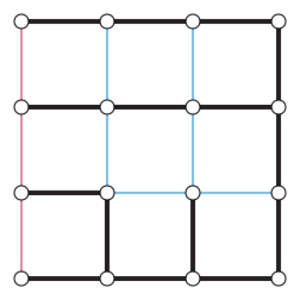Xuong tree
In graph theory, a Xuong tree is a spanning tree [math]\displaystyle{ T }[/math] of a given graph [math]\displaystyle{ G }[/math] with the property that, in the remaining graph [math]\displaystyle{ G-T }[/math], the number of connected components with an odd number of edges is as small as possible.[1] They are named after Nguyen Huy Xuong, who used them to characterize the cellular embeddings of a given graph having the largest possible genus.[2]
According to Xuong's results, if [math]\displaystyle{ T }[/math] is a Xuong tree and the numbers of edges in the components of [math]\displaystyle{ G-T }[/math] are [math]\displaystyle{ m_1,m_2,\dots, m_k }[/math], then the maximum genus of an embedding of [math]\displaystyle{ G }[/math] is [math]\displaystyle{ \textstyle\sum_{i=1}^k\lfloor m_i/2\rfloor }[/math].[1][2] Any one of these components, having [math]\displaystyle{ m_i }[/math] edges, can be partitioned into [math]\displaystyle{ \lfloor m_i/2\rfloor }[/math] edge-disjoint two-edge paths, with possibly one additional left-over edge.[3] An embedding of maximum genus may be obtained from a planar embedding of the Xuong tree by adding each two-edge path to the embedding in such a way that it increases the genus by one.[1][2]
A Xuong tree, and a maximum-genus embedding derived from it, may be found in any graph in polynomial time, by a transformation to a more general computational problem on matroids, the matroid parity problem for linear matroids.[1][4]
References
- ↑ 1.0 1.1 1.2 1.3 Topics in topological graph theory, Encyclopedia of Mathematics and its Applications, 128, Cambridge University Press, Cambridge, 2009, p. 36, doi:10.1017/CBO9781139087223, ISBN 978-0-521-80230-7
- ↑ 2.0 2.1 2.2 Xuong, Nguyen Huy (1979), "How to determine the maximum genus of a graph", Journal of Combinatorial Theory, Series B 26 (2): 217–225, doi:10.1016/0095-8956(79)90058-3
- ↑ "Graphs with 1-factors", Proceedings of the American Mathematical Society (American Mathematical Society) 42 (1): 8–12, 1974, doi:10.2307/2039666
- ↑ Furst, Merrick L.; Gross, Jonathan L.; McGeoch, Lyle A. (1988), "Finding a maximum-genus graph imbedding", Journal of the ACM 35 (3): 523–534, doi:10.1145/44483.44485
 |


